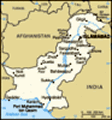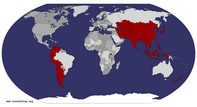Advertisement
The Hunza Valley is said to be the inspiration behind the mythical valley of Shangri-La in James Hilton’s 1933 novel ‘Lost Horizon.’ It’s really not hard to see why.
Rehman is infamous in the Pakistan traveller network for hosting foreigners at his family’s home in Ghulkin, a small village in the Hunza Valley just 15 minutes from Gulmit.
We’d got in touch with him a few days before to see if we could stay the night. Busy hosting a tour for a British Pakistani family he arranged for his wife Sitara to look after us. She called us the night before to arrange for a family friend to collect us from our Gulmit guesthouse early on Saturday morning.
This is Pakistan so little runs on time and our lift was almost an hour late. We didn’t mind, we enjoyed hanging out after breakfast in the guesthouse garden, watching apples fall off the trees and the apricots drying on racks.
As we drove into Ghulkin we passed the Dutch guys and Hamish leaving. A guy from Singapore was at Rehan’s house (also leaving that day) said they’d all been there for the last 2 nights (Karakoram Bikers the
agency we’d all used in Gilgit recommend Rehman). We’d be the only ones there that night which we were stoked to hear as everyone sleeps together in their guest room, a traditional Hunza room, and that meant we had the place to ourselves.
Rehman’s father, Mr Han, was keen to take us out on a trek the moment we arrived. Already hot and with Marie having been sick for so long we tried to explain that short would be ideal but we had the distinct feeling as we headed up to a glacier, on something resembling a goat track through a rocky slope, that his short was not our short.
He speaks some English and we had good conversations about the mountains surrounding us. A true mountain man he has summited a number of peaks, including one of the big nearly 8,000m ones as a porter, meaning he’s effectively climbed it a number of times going back and forth to base camps over the course of 2 months and 22 days. At 72 he could clearly still whip our asses over any terrain.
He did go slow for us, he kept saying it was our time and
he stopped as often as we wanted. Just as well as with the village sitting at 2460m, just 40m shy of high altitude, we could definitely feel the lesser oxygen on the uphill. A kind man he insisted on taking Marie’s bag, she wasn’t stubborn and gladly accepted. He soon learnt where the camera pocket was and would turn around and offer it up every time she wanted it.
Our first destination was black (Gulmit) glacier, so called because of the amount of moraine on it. The viewpoint was at the top of the first rocky slope. It is huge glacier, hundreds of meters wide and far longer than any we had seen before. We sat and admired it for a while listening to small rockfalls as the ice melted. It was definitely alive.
Then he led us down and guided us across it. There is no path, but with his years of experience he picked out the best route. Where he needed to he created one by throwing rocks down small ice faces too big to step down. It was slow going. Rocks of a good size that appeared to be bedded in often weren’t when you
put your foot on them. We took it slowly and carefully and trusted Mr Han would get us across it safely. It was an incredible experience to be clambering across a glacier in a remote part of Pakistan’s Karakoram mountains. The backdrop was huge mountains in all directions, including the amazing jagged peaks of Passu’s Cathedral Range which at their highest reach 6100m.
We were pretty exhilarated by the time we reached the other side. He had navigated us perfectly to a deep cut out in the side that covered an irrigation channel. We could see Borit Lake a short distance away. It felt good to be able to stretch our legs out on the flat as we headed there.
After a chai and toilet stop at the Borit Lake restaurant (which was empty) Mr Han checked we were ok to continue. He was taking us to the viewpoint of white (Passu) glacier, which when we asked he said was an hour flat walk. It was pretty hot in the heat of the day and he warned us it would be a ‘bit hot’, but keen to see and experience as much as we could we nodded our
agreement and stocked up on Mango juice and coconut bars from the small shop attached. The walk to the glacier itself was actually a 4WD track. Despite it being so hot we still enjoyed stretching our legs out as we walked past the lake. We stopped for a break under an apricot tree while Mr Han picked out the best ones. The apricots here are so sweet. Perfect hiking food.
While we were eating them under the shade of the tree branches a 4WD went by. Mr Han made no hesitation in shouting it. A guy he knew, he gave us a lift. It turned out we’d done the flat part and the rest was a steady uphill with no shade. We were grateful for the ride. ‘Lucky, lucky’ Mr Han kept saying. It’s a dead end track that sees little traffic.
At the end was the glacier. We thanked the driver and climbed up the path along its side. A huge white glacier made up it seemed of jagged crevasses opened out in front of us. Not as wide as black glacier it went off into the distance up the mountain. It is a huge 20.5km long.
We followed a path up that clung to the side, staying well away from the edge and the big drop off down to the glacier. We went steadily higher until we got a full view of the whole glacier. Then Mr Han led us to the a spot right on the edge and made us a couple of seats out of rocks so we could sit and relax. He picked badly for Marie’s, a black rock, which after a while heated up. He was full of apologies when he realised.
The walk back to Borit Lake down the track was certainly hot but it also made us more grateful to have gotten the ride up it. We had one mango juice stop in the shade. Mr Han seemed appreciative that we had bought enough for him too. As we got back to the lake he asked if we wanted to swim but knowing we were some kilometres off getting back to the homestay we didn’t fancy walking it in wet undies so passed on the chance.
After another tea stop at the lake restaurant, we headed down the vehicle track up to it from the Highway, cutting
the switchback corners off by free ranging down the hill.
At the Highway we took a seat in the shade while Mr Han watched eagle eyed for a lift we could flag. He told us he once waited 5 hours to get a lift somewhere, such is the quietness of the Highway at times. We were much luckier, we waited only about 20 minutes.
10 minutes down the road at Husseini he got them to stop and we got out where Rehman and he are building a proper guesthouse. It’s not much to look at yet, but they are hoping it will be finished next year. Sitara was there so we got a lift back to their home with her and their youngest 3 kids.
We relaxed for the rest of the day. It had taken us 5 hours to walk 12.5km. Sitara had warned us to get our things charged when we got back as the power was due to go off at 4pm. They have power 1 day in every 3. We duly did and we got our stuff organised for the night as it is so much easier to do it in the light
than by torchlight. We were feeling pleased with ourselves when it went off. Then it inexplicably came back on. When Mr Han returned that night all he could say was ‘lucky, lucky’.
We ate dahl and rice and potatoes for dinner, the same as the family. Sitara joined us. She speaks really good English and we had a good conversation about their lives and ours. They like to host foreigners so they can learn from them, even though it means she is rushing round juggling a teaching job, family and hosting from dawn until dusk. She also explained that the Hunza Valley is religiously Ismaili, a more relaxed sect of Islam, hence no need to wear headscarves.
Rehman arrived shortly before bedtime and having been joined after dinner by Mr Han the 5 of us had a conversation to sort out plans for the next day. Rehman’s group were in a guesthouse in a nearby village and he would be bringing them to his home for lunch, he was insistent we join them and that he would then drop us at Passu village which is where we wanted to go to next.
We slept the best we
have in a long time.
Breakfast was late (as is typical). Sitara was very apologetic, she was running around like usual. Afterwards we took a leisurely walk through the village and spoke to kids and watched apricots being harvested before being put out on the roof to dry. Apples are also dried and fed to the cows in winter in what Mr Han had described as a ‘soup’. Harvesting and drying is a busy time of year for the villages.
After lunch with the Britsh family (who were lovely but clearly had little experience of rural let alone remote) Rehman dropped us at a guesthouse at Passu. We wanted wifi given we’d been without it for a couple of days and we had a bunch of photos to upload before we cross to China, there are only 2 guesthouses that have it and he’d already called 1 and knew they were full, so it was an easy decision.
Advertisement
Tot: 0.273s; Tpl: 0.017s; cc: 26; qc: 161; dbt: 0.1776s; 1; m:domysql w:travelblog (10.17.0.13); sld: 1;
; mem: 1.5mb

























D MJ Binkley
Dave and Merry Jo Binkley
Pakistan
Stunning beauty.